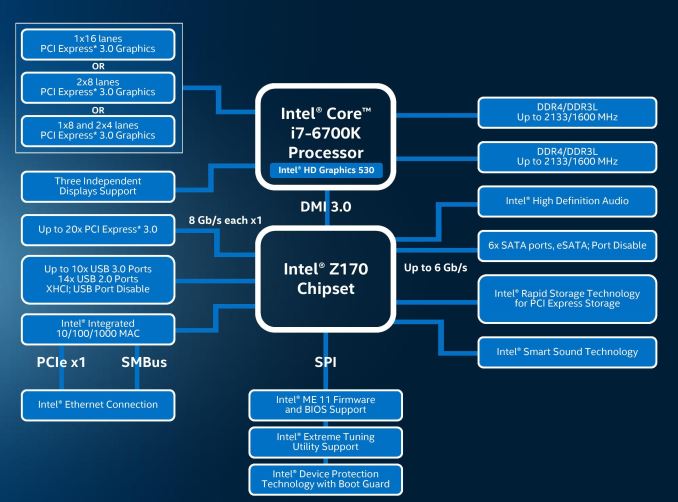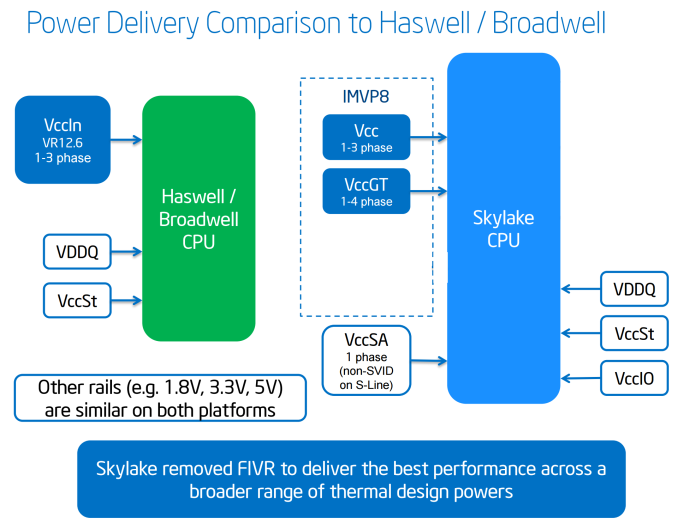The Intel 6th Gen Skylake Review: Core i7-6700K and i5-6600K Tested
by Ian Cutress on August 5, 2015 8:00 AM ESTThe Skylake CPU Architecture
As with any new Intel architecture, the devil is in the details. Previously at AnandTech we have been able to provide deep dives into what exactly is going on in the belly of the beast, although the launch of Skylake has posed a fair share of problems.
Nominally we rely on a certain amount of openness from the processor/SoC manufacturer in providing low level details that we can verify and/or explain. In the past, this information has typically been provided in advance of the launch by way of several meetings/consultations with discussions talking to the engineers. There are some things we can probe, but others are like a black box. The black box nature of some elements, such as Qualcomm’s Adreno graphics, means that it will remain a mystery until Pandora’s box is opened.
In the lead up to the launch of Intel’s Skylake platform, architecture details have been both thin on the ground and thin in the air, even when it comes down to fundamental details about the EU counts of the integrated graphics, or explanations regarding the change in processor naming scheme. In almost all circumstances, we’ve been told to wait until Intel’s Developer Forum in mid-August for the main reason that the launch today is not the full stack Skylake launch, which will take place later in the quarter. Both Ryan and I will be at IDF taking fastidious notes and asking questions for everyone, but at this point in time a good portion of our analysis comes from information provided by sources other than Intel, and while we trust it, we can't fully verify it as we normally would.
As a result, the details on the following few pages have been formed through investigation, discussion and collaboration outside the normal channels, and may be updated as more information is discovered or confirmed. Some of this information is mirrored in our other coverage in order to offer a complete picture in each article as well. After IDF we plan to put together a more detailed architecture piece as a fundamental block in analyzing our end results.
The CPU
As bad as it sounds, the best image of the underlying processor architecture is the block diagram:
From a CPU connectivity standpoint, we discussed the DDR3L/DDR4 dual memory controller design on the previous page so we won’t go over it again here. On the PCI-Express Graphics allocation side, the Skylake processors will have sixteen PCIe 3.0 lanes to use for directly attached devices to the processor, similar to Intel's previous generation processors. These can be split into a single PCIe 3.0 x16, x8/x8 or x8/x4/x4 with basic motherboard design. (Note that this is different to early reports of Skylake having 20 PCIe 3.0 lanes for GPUs. It does not.)
With this, SLI will work up to x8/x8. If a motherboard supports x8/x4/x4 and a PCIe card is placed into that bottom slot, SLI will not work because only one GPU will have eight lanes. NVIDIA requires a minimum of PCIe x8 in order to enable SLI. Crossfire has no such limitation, which makes the possible configurations interesting. Below we discuss that the chipset has 20 (!) PCIe 3.0 lanes to use in five sets of four lanes, and these could be used for graphics cards as well. That means a motherboard can support x8/x8 from the CPU and PCIe 3.0 x4 from the chipset and end up with either dual-SLI or tri-CFX enabled when all the slots are populated.
DMI 3.0
The processor is connected to the chipset by the four-lane DMI 3.0 interface. The DMI 3.0 protocol is an upgrade over the previous generation which used DMI 2.0 – this upgrade boosts the speed from 5.0 GT/s (2GB/sec) to 8.0 GT/s (~3.93GB/sec), essentially upgrading DMI from PCIe 2 to PCIe 3, but requires the motherboard traces between the CPU and chipset to be shorter (7 inches rather than 8 inches) in order to maintain signal speed and integrity. This also allows one of the biggest upgrades to the system, chipset connectivity, as shown below in the HSIO section.
CPU Power Arrangements
Moving on to power arrangements, with Skylake the situation changes as compared to Haswell. Prior to Haswell, voltage regulation was performed by the motherboard and the right voltages were then put into the processor. This was deemed inefficient for power consumption, and for the Haswell/Broadwell processors Intel decided to create a fully integrated voltage regulator (FIVR) in order to reduce motherboard cost and reduce power consumption. This had an unintended side-effect – while it was more efficient (good for mobile platforms), it also acted as a source of heat generation inside the CPU with high frequencies. As a result, overclocking was limited by temperatures and the quality of the FIVR led to a large variation in results. For Skylake on the desktop, the voltage regulation is moved back into the hands of the motherboard manufacturers. This should allow for cooler processors depending on how the silicon works, but it will result in slightly more expensive motherboards.
A slight indication of this will be that some motherboards will go back to having a large amount of multiplexed phases on the motherboard, and it will allow some manufacturers to use this as a differentiating point, although the usefulness of such a design is sometimes questionable.












477 Comments
View All Comments
wishgranter - Wednesday, August 5, 2015 - link
Ian, for the overclocking lok here. a better ES samplehttp://www.guru3d.com/articles_pages/core_i7_6700k...
Khenglish - Wednesday, August 5, 2015 - link
It's a shame this doesn't have the 128MB L4 cache. It obviously helps Broadwell over Haswell in CPU benchmarks. If Skylake had it it'd be a clear and very significant upgrade over Haswell, but without it it's just too minor to warrant an upgrade over Haswell or Ivy Bridge.Brazos - Wednesday, August 5, 2015 - link
Is this what happens when AMD stops being a competitor?And I agree with the comments about the IGPU. Most enthusiasts will purchase a graphics card. Save money, space etc by dropping it.
Jumangi - Wednesday, August 5, 2015 - link
Welcome back to the early 2000's when Intel could put out miniscule upgrades while charging premium prices because of the lack of any real competition.A 25% increase over a 4 year old CPU...pathetic.
Gigaplex - Wednesday, August 5, 2015 - link
AMD was very competitive early 2000s.zodiacfml - Thursday, August 6, 2015 - link
Hmm, you kind have a point. Though Intel is relentless with innovation as to chase their dreams on mobile and server market, Skylake architecture seems optimized for server/computing applications. I think it has been that way for many years already. Maybe, the overclocking support Intel is giving to enthusiast is a sign of this. If AMD were competitive, Intel wouldn't have to optimize too much on the server/computing performance.I'm baffled, there's obvious IPC increase and massive improvements in multithreading/Handbrake, but doesn't show in games. With DX12, I doubt it will help.
Eidorian - Wednesday, August 5, 2015 - link
I am frankly looking at Skylake for the platform as a whole. The improvements between generations are not amazing and disconcerting for gaming but I am coming from a Lynnfield + P55 system built in 2009. This is going to be great for me. I can still see users on Sandy Bridge + P67 holding on to those systems a little longer.postem - Wednesday, August 5, 2015 - link
I was reluctant to upgrade to devils canyon, from 950 Bloomfield due to this 6 month proximity to skylake.I never had severe performance issues with the 950 @ 4.2 Ghz, but since i started to use a 980 i saw the frames consistently dropped below.
When i finally updated to 4790K, man it was good. Not only better response on overall processing, better frames, much faster in all aspects.
Bottom line: i dont think you need to upgrade each generation. I would gladly gone to Haswell-E if it wasnt so $$$, but anyway, DC is giving me a hell of performance, and i dont think its worth considering to ugrade it to skylake. It just sucks intel changed the whole socket because of a pin.
If you are comming from a 3-4 generations before, you will really see the benefits from the upgrade i can assure you. I cant say its the end of Sandy Bridge, but its coming to its age.
What really is getting nice is to have good cpus with minimal TDP on laptops. You can have a broadwell i5 with low as 10W consumption.
MrSpadge - Wednesday, August 5, 2015 - link
Ian, could you please undervolt the chips? I know you reported 1.20 v at 4.3 GHz as "undervolting", but that's far more than I'd give even a 32 nm CPU and is just considered low because the stock voltage is so insanely high. Give us a few more data points until about 4.0 GHz, please.Flunk - Wednesday, August 5, 2015 - link
I've got a 2500K overclocked to 4.4Ghz @ 1.2v.